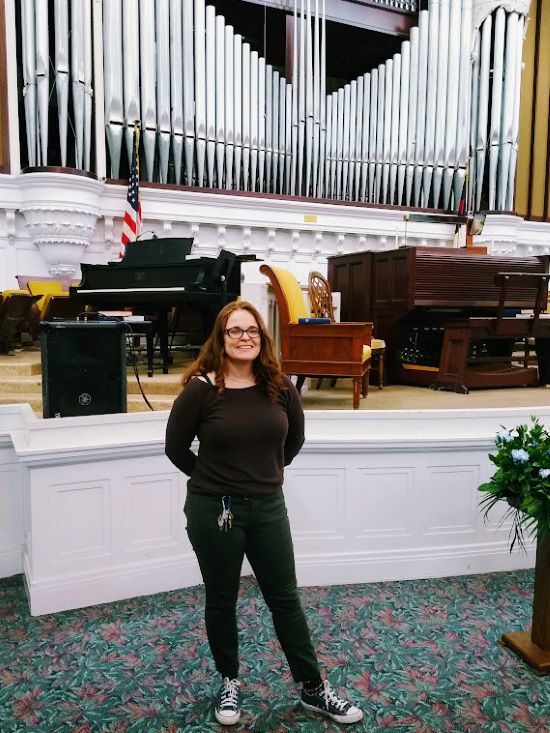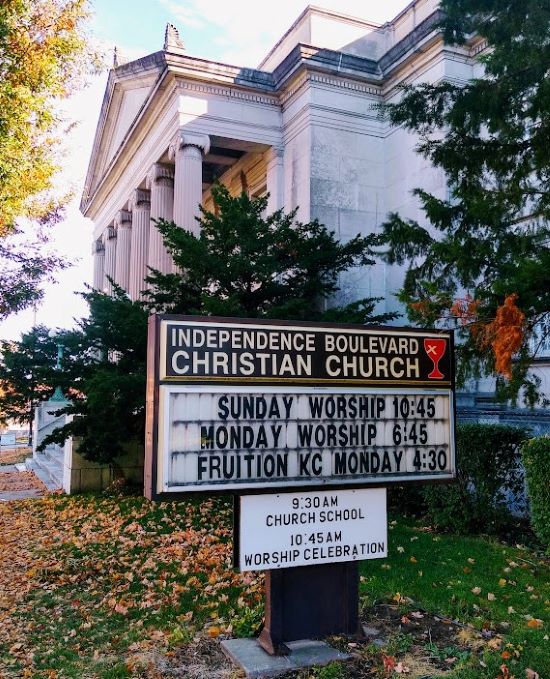Small Congregations Rethink the Role of Big Historic Churches Saving Grand Structures
Published November 27th, 2022 at 6:00 AM
Above image credit: Independence Boulevard Christian Church, which was constructed at its current site in 1905. (Bill Tammeus | Flatland)Two years ago, when the Rev. Mindy Fugarino became pastor of the once-crowded Independence Boulevard Christian Church in Kansas City’s northeast neighborhood, she had no trouble counting how many people attended the first worship service she led — 13.
“Like many churches,” says Don Robeson, vice president of Friends of Sacred Structures (FOSS), “that church is finding an alternate path rather than relying on their people on Sunday mornings.”
As the congregation seeks a different future, FOSS is helping rescue the deteriorating building, built in 1905 with major financial help from lumber baron and philanthropist R.A. Long, whose nearby mansion now is the Kansas City Museum.
It was a church that, in its early decades, “expanded and expanded and expanded,” Robeson says.
But now, says Fugarino, “I’m just not worried about (the number of) members. In the past, our model has been trying to find members. Thinking of funding models that are different from that is what we’re trying to do now. Even if we quadrupled our attendance with more of our neighbors, we would not sustain this space solely with resources from members.”

Fugarino’s church is not unique. As Robeson notes, similar circumstances are forcing other churches — “and there are dozens and dozens of them all over the metropolitan area — to seek out more of a community and perhaps even secular solution to the economics of maintaining a great old building.”
So today, churches experiencing the changing American religious landscape are seeking different paths forward.
For instance, the Independence Boulevard church offers hundreds of hot meals to the needy each week. It houses a school and a medical clinic and it searches for ways to be what Fugarino, using traditional Christian theological language, calls “the body of Christ.”
“This congregation,” she acknowledges, “has been living off (financial) legacies from years gone by.”
That can’t go on much longer. But she’s insistent on trying to find a useful role for her congregation, which is part of the Mainline Protestant denomination called the Christian Church (Disciples of Christ). And she’s grateful to FOSS for help in identifying what must happen to save the old building, beginning with sealing it from outside weather and installing a new heating and air conditioning system.
All of which requires new thinking about what it means to be a church.
“We call it the body of Christ,” Fugarino says, “but maybe a better term is children of God, representing love and dignity, which is what was always intended by Christ. So that’s what we’ve been doing with hundreds and hundreds of volunteers. And that’s church, too. It’s not defined by numbers on membership rolls. Most volunteers here would not call this their church home because they have other places they’re connected with.
“But this is kind of an intersectional place. This is the largest gathering space in the northeast. And we’d like to be an effective space for diverse groups to come together around common ground and common dignity.”
It can’t happen without a safe building, however. So FOSS is trying to help renovate it, as it has done with many other sacred structures since 1992.

“We’ve tried to reimagine the building as more than a place for member activities,” says Fugarino. ”I actually think that early leaders in the congregation had a similar vision, but that was an era when many households saw their church as their primary source of social engagement. At that time, members and community alike gathered for everything from swimming (the church once had a pool) to live theater performances.
“As the decades passed and society shifted its social investment from churches to many other options, this congregation spent a lot of years trying to reclaim that role for members. But when you have fewer members and busier members, doing the former activities and burning out the few hard-core worker bees of the church, the spirit tends to be one of stress rather than joy.”
So more than two decades ago, the church created its Micah Ministry, which still feeds hundreds of people each week, in addition to offering hygiene products, clothing, a free medical clinic and more. Community support — not funding from the congregation itself — sustains most of it.
With that as a model, says Fugarino, “we hope to be a space where diverse groups can intersect to share life-giving experiences and to engage in deeper ways. We don’t know the results of such encounters, but we hope to nurture collaborative partnerships, opportunities to see and mutually honor dignity and connections that will truly invest in the common good. There’s breaking bread but there’s also breaking barriers. And we have to do both of those things.”
If the mission of the Independence Boulevard church has changed, so has that of FOSS.
“FOSS,” says Roberson, “started out trying to save buildings built for religious purposes. Then we decided to focus on groups that were really focused on community, such as after-school daycare.”
So today FOSS pays less attention to saving worship spaces and more to saving spaces in faith-based structures that house community programs, which is exactly the vision of Fugarino’s congregation. It hopes to be a community space for concerts, film screenings, art classes and exhibits, farmers/vendors markets that go year-round, cooking and other skill-share classes, theater productions, self-defense and other classes, fund-raising galas for local partners and even a kitchen to rent to entrepreneurial caterers.

“The goal,” says Fugarino, “obviously is to get near the heart of Jesus and what he represented. But we change the salvation story to be something about debts owed. The idea of Jesus being in solidarity with those who are oppressed, even as he hangs on the cross, is the story that we miss. That’s what he cares about.
“The irony here is that I’ve never been a person who thinks that you’ve got to get a golden building or that you even need to have a building for a church. But that’s the biggest resource we are sitting on. So we’re focusing on the building in order to focus on the people around us. It’s not about getting people into the pews, but it’s getting people connected with what I like to think of more as the Beloved Community.”
That may make Independence Boulevard Christian Church a model for many other churches that also confront the reality that traditional Christian congregations are shrinking and even disappearing in America. And as they vanish, so does the community support churches provide.
Bill Tammeus, an award-winning columnist formerly with The Kansas City Star, writes the “Faith Matters” blog for The Star’s website, book reviews for The National Catholic Reporter and for The Presbyterian Outlook. His latest book is “Love, Loss and Endurance: A 9/11 Story of Resilience and Hope in an Age of Anxiety.” Email him at wtammeus@gmail.com.


